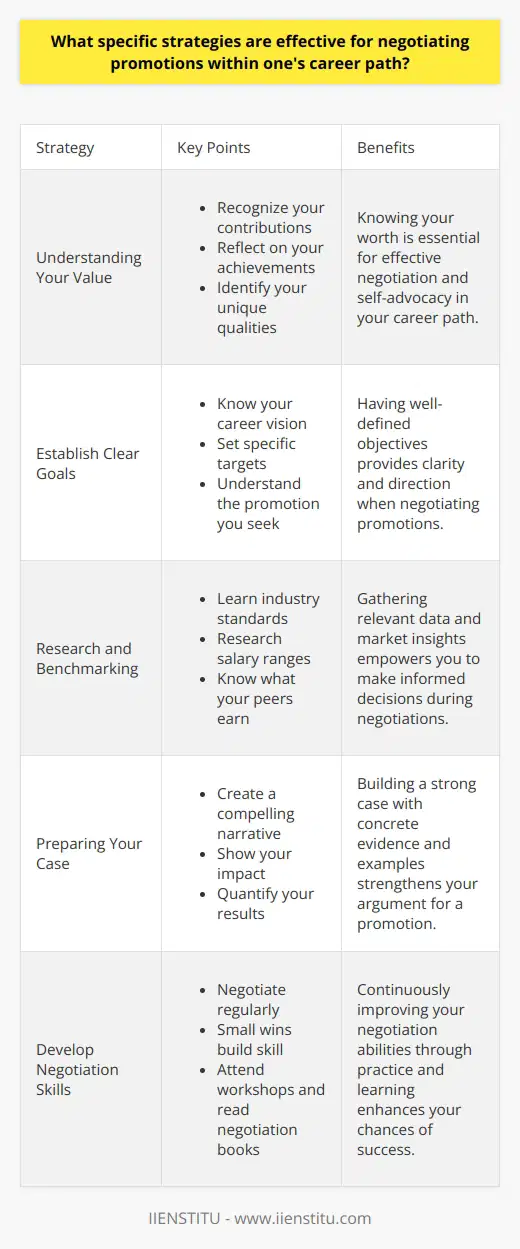
The trajectory of one's professional life, commonly referred to as a career path, is a vital compass that guides individuals through the ever-evolving landscape of work and ambition. Understanding the nature of your career path is not merely about the progression of titles and financial gain; it's about carving a niche that aligns with one's vision, abilities, and personal satisfaction. Recognizing the profound significance of a thoughtfully crafted career progression, this blog post delves into a myriad of considerations, strategies, and challenges that one must navigate for effective career development and advancement.
From aligning your personal interests to overcoming potential hurdles in the job market, we will explore how to strategically move forward and make decisions that bolster personal and professional growth.
Factors to Consider in Choosing a Career Path
Personal Interests and Passions
Immersing oneself in a career that resonates deeply with individual passions can lead to not only a more enjoyable professional journey but also to a higher level of success and fulfilment. Choices grounded in one's affinities ensure that motivation and engagement remain high, acting as fuel in the pursuit of career excellence.
For instance, an individual drawn to creative expression might find immense satisfaction within the fields of design or writing, their personal inclinations acting as a beacon throughout their career. Thus, assessing one's passions is an indispensable element in the formulation of a career path that is both rewarding and sustainable.
Skills and Talents
While passion ignites the spark for a chosen career, it is the alignment of innate skills and talents with the professional route that ensures the enduring flame of success. A solid understanding of one’s abilities can open doors to opportunities that might have otherwise remained unexplored.
Case studies from industry leaders continually reveal that individuals who lean into their natural talents often rise to the top of their fields. A data analyst, for example, whose intrinsic knack for pattern recognition and statistical insight can excel in roles that are heavy on data interpretation, enhancing their career trajectory significantly.
Career Goals and Objectives
Without clear direction, a career can quickly become an aimless journey. Setting tangible short-term and long-term goals provides a roadmap for one's professional development. It is beneficial to periodically evaluate these objectives, adjusting them to reflect personal growth and changes within the job market.
Methods such as SMART (Specific, Measurable, Achievable, Relevant, Time-bound) goals can assist in creating targeted and realistic career ambitions that not only guide day-to-day tasks but also inform the larger trajectory of professional advancement.
Steps to Define Career Path
Self-assessment
An integral step towards carving out a distinct career path is the process of self-assessment. It involves a thorough analysis of one's qualifications, strengths, weaknesses, and interests. These insights form the foundation upon which career decisions are built. Recommended methodologies such as personality tests, career aptitude assessments, and professional feedback can yield valuable perspectives that are crucial for determining a suitable professional journey.
Exploration
The exploration phase is characterized by a broad, investigative approach towards understanding the different options within the vast expanse of career possibilities. It may entail research, informational interviews, or immersion in potential fields of interest. A noteworthy example comes from an individual who, through exploration, transitioned from a career in finance to tech start-ups, benefiting greatly from an informational landscape that allowed for analysis and reflection.
Decision Making
After accumulating the necessary information through self-assessment and exploration, making informed decisions becomes the logical next step. This phase requires careful consideration of the potential longevity, financial stability, and personal satisfaction of each option. At this juncture, it's also vital to weigh factors such as industry demand, company culture, location, and work-life balance.
How To Align Hrm Strategy And Leadership To Create Successful Employer Brand
How To Answer Why İs Problem Solving İmportant İnterview Question
Implementation
The myriad of contemplations and decisions eventually culminate in the implementation phase. This crucial stage involves taking active steps such as job applications, networking, or further education to put the chosen career path into motion. Techniques and strategies might include optimizing one’s resume for desired job roles or engaging in an hr certificate course for those interested in human resources, laying down the groundwork for a more proficient entry into the field.
Challenges in Career Path Development
Unclear Goals
One common obstacle on the road to career success is the presence of ambiguous goals. When objectives are not clearly defined, it can lead to fragmented efforts and a lack of direction. To surmount this obstacle, setting precise goals, as mentioned earlier, is crucial. It provides a much-needed focal point and a basis to measure progress.
Skills Gap
In an ever-evolving job market, a discrepancy between one's current skills and the requirements of desired job roles or promotions—a skills gap—can hinder career progression. To bridge this gap, proactive measures such as enrollments in relevant online courses, certifications, and continuous professional development are imperative. These steps demonstrate a commitment to self-improvement and adaptation which are highly regarded in the professional realm.
Lack of Networking
Networking plays a fundamental role in opening the door to new opportunities and insights within one's chosen field. A lack of networking can significantly impede one's ability to progress, often leaving individuals isolated from industry trends, potential mentors, and job opportunities. Engaging in professional organizations, attending industry events, and establishing a robust online presence can augment networking channels and provide valuable connections.
Navigating Career Path Changes
Reasons for Career Shift
At certain junctures, individuals may find themselves at a crossroads, contemplating a pivot in their career trajectory. Changes in personal interests, industry transformations, or the pursuit of better work-life balance can prompt such a shift. An inspiring case involves a marketing executive who shifted to non-profit management, driven by a newfound desire to work within a socially impactful domain.
Preparing for the Shift
Transitioning to a new field requires thoughtful preparation, from acquiring new skills to understanding the nuances of the new industry. Building on previous experiences while also venturing into new territory with humility and eagerness to learn marks the process. For example, undertaking an online course in a different discipline or volunteering to gain field-specific experience can be tangible steps towards a successful career pivot.
In conclusion, navigating one's career path is a multifaceted process that extends beyond simple job changes or promotional achievements. It entails a series of informed choices, reflective self-assessment, and purpose-driven goals. This journey is punctuated by continual learning, adaptability, and the willingness to embrace change.
By actively engaging in each step and considering the discussed strategies and challenges, individuals can gracefully steer their career in a direction that promises both professional prosperity and personal fulfilment. As we each forge our paths, no small amount of courage is required, but the rewards of a well-planned career are both substantial and deeply rewarding. The encouragement here is to continue the journey with passion, persistence, and strategic planning.
Frequently Asked Questions
What specific strategies are effective for negotiating promotions within one's career path?
Understanding Your Value
Recognize your contributions. Reflect on your achievements. Identify your unique qualities. It matters.
Establish Clear Goals
Know your career vision. Set specific targets. Understand the promotion you seek. Clarity is key.
Research and Benchmarking
Learn industry standards. Research salary ranges. Know what your peers earn. Information empowers negotiation.
Timing is Crucial
Choose the right moment. Time your request after successes. Avoid downturns or cutbacks. Timing enhances receptivity.
Preparing Your Case
Create a compelling narrative. Show your impact. Quantify your results. Facts support your argument.
Communicating Effectively
Practice your pitch. Convey confidence. Address potential concerns proactively. Communication influences outcomes.
Build Relationships
Network internally. Seek mentors and allies. Strong relationships foster support. You don't advance alone.
Be Flexible
Consider various outcomes. Be open to different paths. Flexibility can yield unexpected opportunities.
Develop Negotiation Skills
Negotiate regularly. Small wins build skill. Attend workshops. Read negotiation books. Practice improves ability.
Follow Up
Persistence is necessary. Follow up professionally. Reinforce your commitment. Silent waiting won't suffice.
Contingency Planning
Prepare a plan B. It shows preparedness. Negotiating with alternatives strengthens your position. Always have backup.
Stay Professional
Maintain professionalism. Regardless of the outcome, remain courteous. Positive interactions leave doors open. Reputation matters.

How can one identify and capitalize on pivotal career advancement opportunities?
Understanding Pivotal Career Opportunities
Identifying career advancement opportunities requires vigilance. Career landscapes change rapidly. Professionals must remain adaptable and observant. Opportunities often arise unexpectedly. They might appear during organizational shifts, projects, or industry changes.
Recognize Your Value
Assess your unique value proposition. What skills set you apart? Understand your strengths thoroughly. They are your career leverage. Reflect on your contributions and successes. Document achievements regularly. This documentation aids in recognizing future opportunities.
Expand Your Network
Networking builds career capital. It extends beyond your immediate circle. Seek diverse professional connections. Engage with individuals across various roles and industries. Attending events, joining forums, and participating in professional groups are key. Each interaction might unveil a crucial opportunity.
Perfect Your Timing
Timing proves essential for advancement. Watch for industry trends and developments. They may hint at upcoming opportunities. Economic shifts can open new paths. Stay current with company news. Align your readiness with organizational changes. This alignment better positions you for opportunities.
Cultivate a Learning Mindset
Adopt continuous learning. It maintains your competitiveness. Enroll in courses. Attend workshops. Learn new technologies. Each skill acquired opens doors to advancement. Employers value proactive learners.
Express Your Aspirations
Articulate your career goals. Do this with your superiors. Do it clearly and confidently. Leaders cannot read minds. Sharing your goals can lead to targeted advice. It can also steer you toward relevant opportunities.
Strategically Volunteer
Volunteer for new projects. Choose wisely. Select projects aligned with your career goals. These projects should challenge you. They often expose you to new skills and networks. They demonstrate your initiative and versatility.
Seek Feedback
Request regular feedback. Feedback provides insights into your performance. It directs your development efforts. It highlights both strengths and areas for improvement. Constructive feedback can guide you to key opportunities.
Monitor Job Openings
Watch for internal and external job postings. Understand what employers seek. Align your resume accordingly. Tailor it to demonstrate your suitability. A well-aligned application stands out.
Demonstrate Leadership
Showcase leadership qualities. Take charge when necessary. Lead smaller projects or teams. Leadership displays potential. It signals readiness for larger roles. Employers notice these efforts.
Leverage Social Media
Utilize professional platforms like LinkedIn. Keep profiles updated. Share your achievements and projects. Engage with content from industry leaders. Your online presence can attract opportunities.
Assess Risk Versus Reward
Evaluate opportunities carefully. Consider benefits and drawbacks. What are the potential impacts on your career? Choose paths with calculated risks, offering significant growth potential.
Negotiate Smartly
Own your career path. Negotiate terms that foster your professional growth. Discuss role responsibilities openly. Ensure they match your career objectives. Proper negotiation can cement your advancement.
Capitalizing on Opportunities
Once identified, seize opportunities decisively. Display confidence in your abilities. Approach new challenges with enthusiasm. Take calculated risks. Trust your instincts and experience. Remember that advancement requires effort and sometimes stepping out of comfort zones.
Leverage every learning avenue. Build a strong, supportive network. Articulate goals. Volunteer strategically. Request feedback. Stay abreast of openings. Exhibit leadership. Optimize social media presence. Assess risks and rewards. Negotiate for your career growth. These approaches enable the capitalization on pivotal career opportunities, paving the way to professional advancement and success.

What role does mentorship play in the progression of one's career and how can it be effectively implemented?
The Essential Role of Mentorship
Mentorship stands as a pillar in career advancement. It embodies the transfer of knowledge and skills from experienced individuals to novices or less experienced ones. Mentors guide, inspire, and challenge their mentees to excel and grow within their chosen fields.
Catalyst for Professional Growth
Mentorship acts as a catalyst in one’s professional journey. It can unlock potential and uncover hidden strengths. Mentors often help mentees navigate complex workplace dynamics. They also provide crucial insights into industry trends and practices. This guidance accelerates career progression.
Networking Enhancer
Mentorship opens doors to extensive networks. Mentors can introduce their proteges to key contacts. These relationships might lead to new opportunities. In many cases, these connections are pivotal for career development.
Confidence Builder
Mentees often gain confidence through mentorship. They receive encouragement and constructive feedback. This helps them take calculated risks. It also allows them to embrace new challenges.
Implementation Strategies for Effective Mentorship
To effectively implement mentorship, organizations and individuals must adopt intentional strategies. These ensure that the mentorship experience is beneficial for both mentors and mentees.
Structured Programs
Establishing structured mentorship programs is key. These should have clear objectives and outcomes. They should also include training for mentors on how to foster development in their mentees.
Regular Check-Ins
Effective mentorship requires regular interaction. Schedule consistent meetings. These encourage ongoing dialogue and give structure to the mentorship.
Goal Setting
Mentorship should focus on set goals. Mentors and mentees must discuss and agree on these objectives. They ensure that both parties are working towards tangible outcomes.
Feedback Mechanisms
Implement feedback channels. They allow mentors and mentees to assess the mentorship. This can lead to improvements in the process.
Diverse Matches
Pair mentors and mentees from different backgrounds. Diversity can encourage innovative thinking. It can also challenge biases and assumptions.
Encourage Reciprocity
Mentorship should benefit both parties. Encourage mentees to share their perspectives and skills. This approach enhances the learning experience for mentors as well.
In conclusion, mentorship is a dynamic and pivotal element in career development. It merges guidance with empowerment. It forms networks and nurtures confidence in professionals. By effectively implementing mentorship strategies, individuals and organizations can reap significant benefits. These include accelerated career growth and improved job satisfaction. Mentorship paves the way for a future of skilled, confident, and interconnected professionals.



